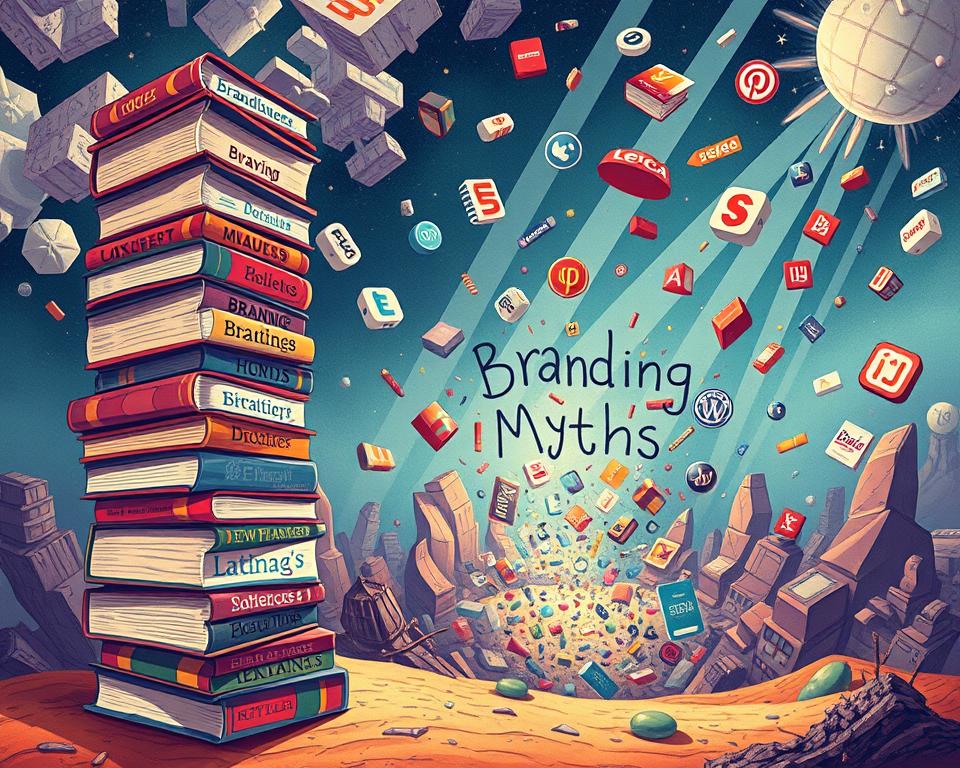Анунсиос
Branding examples show how a brand can earn trust and cut through noise — but are you ready to test those moves in 2025?
In a world where over 500,000 brands compete and 81% of people need to trust a brand before buying, clarity matters. You’ll learn step-by-step moves you can adapt to your business, from purpose and positioning to visual identity and website performance.
This guide ties each step to measurable signals you can track across channels. We study well-known names like RXBAR, Dollar Shave Club, and The Sill alongside emerging players such as Imperfect Foods and Death Wish Coffee to extract patterns you can reuse without copying.
Start small, test ideas, and iterate with data. The intro here focuses on defining who you are, who you serve, and the outcomes you enable. Use this as a reference checklist to keep your identity coherent across touchpoints without expecting guarantees.
Introduction: Why Branding examples matter for mastering branding in 2025
Attention is the new currency in 2025, and your brand must earn it one clear impression at a time. You need simple signals that build trust fast. This section explains why clear identity choices matter and how to use short cases to speed learning.
Анунсиос
The 2025 context: trust, consistency, and crowded channels
People expect consistent experiences across channels. 81% of consumers need to trust a brand before they consider buying, and awareness often takes 5–7 impressions.
Social media reaches over 4.9 billion users, so your visual identity, logo, colors, and imagery must be consistent to cut through. Many teams create style guides, but only about 30% enforce them regularly, which causes mixed experiences.
How this guide works: step-by-step with real brand cases
- Each step gives a task, a checklist, and a mini case from brands in your industry.
- See how elements like logo, colors, and design patterns form a cohesive identity.
- Use examples as decision accelerators: they show what to try, what to avoid, and how to measure results.
This guide is practical and test-driven. You’ll get things you can try quickly and scale only when data shows they work. Trust grows through repeated, consistent behavior—not one-off campaigns—so treat each tactic as a step in a long-term relationship with your customers.
Анунсиос
Define purpose and positioning before design
A focused purpose gives your team a north star for identity and product choices.
Craft a one-sentence mission that states who you serve, the problem you solve, and the outcome you enable. This creates a clear mission your team can test with real customers.
Craft a clear purpose and mission customers can feel
Translate that mission into 3–5 value statements customers can sense. Tie each value to a single, repeatable behavior your team does every day.
Map values to differentiators you can execute
- Position: Write a “for/helps/unlike” line and validate it in early interviews.
- Name: Pick a name that supports position; check trademark and domain availability.
- Proof: Link values to features, service standards, or policies customers notice.
- Story: Document a short brand story that connects belief to benefit and is easy to retell.
Delay decisions on logo, color, and visual identity until your positioning is locked. Set strategy guardrails that state what you will not do and which customers you will not serve. This keeps your identity focused and prevents costly redesigns.
Know your audience deeply and segment smartly
When you map real customer needs, your идентичность бренда stops guessing and starts connecting.
Start small and stay ethical: interview real customers, run short surveys, and observe buying moments. Build three lightweight personas — primary, secondary, and tertiary — using jobs-to-be-done, pains, gains, and decision triggers.
Personas, needs, and behaviors that inform brand choices
Focus on behavior and context, not just age or ZIP code. Capture channel habits: which social media they use, what content they trust, and when they search. Use that to shape your content, color, and logo choices so your presence matches how people act.
Local, niche, and community angles for small businesses
- Prioritize two segments that fit your product and test with small offers or landing pages.
- Document objections per segment and plan clear messages and proof points.
- Lean local: partner with events, community pages, and micro-influencers to build authentic signals big brands miss.
Want practical segmentation tactics? See audience segmentation ideas at audience segmentation ideas and adapt them to your market.
Study competitors and find openings you can own
Treat competitors as data points: you want patterns, not opinions, to shape your identity and offers.
Direct vs. indirect rivals and where you can win
List both direct and indirect competitors so you see the real choice set.
- 5 direct: local leader, national chain, niche challenger, online pure-play, premium artisan.
- 5 indirect: substitutes, DIY, third‑party marketplaces, adjacent product lines, doing-nothing option.
Audit framework to spot white space
Build a compact comparison grid with 3–5 columns and 3–5 rows. Use public data only.
- Columns: product/service scope, price bands, channels, messaging themes, customer reviews.
- Rows: each competitor (3–5 high-priority rivals) so patterns appear fast.
Scrape reviews ethically and rank top complaints and delights. Turn leading complaints into credible opportunities you can own now.
Decide what you lead with and what you avoid
Pick one narrow promise to test (speed, selection, quality, or service) and one long-term moat to build.
Test your positioning with small A/B ad tests against competitor landing pages and measure click-through and bounce.
Document clear ways you win and ways you won’t compete to prevent drift. Track industry shifts quarterly and align moves to your capacity and strategy.
Build a cohesive brand identity system
Your identity should be a toolkit, not a trophy—built to work across web, packaging, and uniforms. Start with a short list of core elements and make rules that teams can follow every day.
Core elements to define
Document your логотип families, brand colors with hex and CMYK values, type scales, and imagery direction. Add voice rules and simple templates so people know what to use and when.
Choose an approach that fits your personality
Pick shape, typographic, color, or illustration branding—or a hybrid. Each approach gives different affordances: shape adds markability, type signals tone, color builds immediate recall, and illustrations add warmth.
Style guide fundamentals and enforcement
Write a concise brand style guide with do/don’t lists, logo clear space, minimum sizes, and incorrect uses. Include web-safe palettes, dark-mode rules, and accessibility contrast checks.
- Set image rules: subject, lighting, and framing so imagery feels coherent.
- Host an asset library and require simple approvals for new uses.
- Run quarterly audits to track compliance—partial application weakens signals.
Plan for scale: define how the system flexes for campaigns, co-branding, and new product lines without breaking the visual identity.
Tell a brand story that connects emotion to utility
Stories that pair emotion with useful outcomes win attention and create trust. Your brand story should do more than explain origin. It must state what you believe, the problem people face, the proof you offer, and the clearer outcome customers get.
From beliefs to benefits: story frameworks that resonate
Start with a simple frame: belief → problem → proof → outcome. Use this to write a two-sentence hook for top-of-funnel and a 150-word version for product pages.
- Belief: state one conviction that guides choices and identity.
- Problem: name the concrete pain people face in everyday terms.
- Proof: show how your product or service reduces friction with data or a short testimonial.
- Outcome: describe the new reality customers enjoy after use.
Tie your mission to specific moments in the customer journey. Show how your content, color cues, and small rituals reduce friction or add delight. Use voice and personality consistently and back claims with evidence so emotion has grounding.
Keep versions short and visual. Use the two-sentence hook in ads and social posts. Use the longer story in your about page and product detail pages. Revisit the narrative twice a year to add fresh proof while keeping the core sense intact.
Plan channels and experiences: website, social, and physical touchpoints
Map where people find you first and shape experiences that answer questions fast. Start by listing the channels your audience uses and decide which role each plays in your funnel.
Website and organic search: your primary brand hub
Treat your website as the canonical source of truth. Align site structure, technical SEO, and on-page content so search engines and customers understand your brand quickly.
Action: map pages to journey stages, add proof points, and run 8–12 week content sprints to test what drives traffic and conversion.
Social media presence and community-building
Pick one or two platforms your audience already uses. Set a simple posting cadence and clear interaction rules so your presence feels dependable.
Use AMAs, user spotlights, and helpful replies to turn broadcast into community. Measure social for reach and engagement, not just clicks.
Retail and service experience design for consistency
Design store rituals—greetings, signage, and packaging—that mirror your online identity. Standardize response times, returns, and uniforms to keep the same customer feeling everywhere.
- Define each channel’s role: website for education and conversion; social for community; retail for loyalty and referrals.
- Pilot new channels in 8–12 week sprints and document learnings for your business.
Execute with consistency across content and design
Operational habits make identity useful every day. Build routines that reduce guesswork and keep your visual identity stable across channels.
Clarity, consistency, commitment: daily operating principles
Clarity: enforce one clear message per asset, plain language, and a visible call to action. Remove jargon that blurs your brand.
Consistency: turn your руководство по стилю into templates for decks, ads, emails, and social posts so the same logo, colors, and tone appear fast.
Commitment: set a weekly brand review to check logo usage, color application, and voice across top channels. Catch drift early.
- Create an asset library with master files and usage notes; restrict editing to approved users.
- Set SLAs for publishing and responses so timing becomes part of your identity.
- Train teams quarterly with before/after examples to embed brand style and guide updates.
- Measure compliance rates and link them to business outcomes like engagement and conversion.
Data point: many brands have guidelines, but only a minority enforce them regularly. Operationalizing the three Cs reduces inconsistency in logo, tone, and visuals.
Начните с малого: pick three metrics to track this quarter and celebrate teams that keep your brand strong. Positive reinforcement sustains commitment when work gets busy.
Измеряйте, изучайте и итерируйте данные
Turn guesses into evidence by tracking how people discover, recall, and feel about your identity.
Brand health metrics to track
Build a simple dashboard that shows the signals that matter to your business.
- Branded search volume and direct traffic — early signs of awareness.
- Recall surveys and short NPS pulses — capture memory and loyalty.
- Repeat purchase rate and support CSAT — measure experience quality.
- Social sentiment and assisted-touch views — see how media mix shapes perception.
Experimentation: small, responsible tests
Run controlled A/B tests to compare headlines, messages, taglines, and light design changes.
- Keep one variable per test and start on the website or in ads.
- Test identity tweaks in low-risk spots (emails, paid media) before changing core assets.
- Use 5–7 impression guidance for awareness — expect gradual lifts, not instant wins.
Pair numbers with conversations: combine qualitative feedback with quantitative results to learn why a variant worked.
Document hypothesis, setup, and outcome for every experiment. Set cadences: monthly for messages, quarterly for design tweaks, and yearly for larger repositioning. Over time, this playbook helps your brand and product choices scale with confidence.
Branding examples to learn from in 2025

Look to real-market moves to see how small shifts in design and copy change customer belief fast.
RXBAR — ingredient-first packaging
RXBAR lists core ingredients on the front of the pack to signal transparency. Test a variant where your top three ingredients or materials are prominent to see if trust and conversions rise.
Кончик: keep the logo smaller and let typography carry the message so facts read easily on shelf and online.
Death Wish Coffee — darker palette and bold voice
Death Wish uses deep brand colors and a brash tone to fit hardcore drinkers. A/B test bolder copy and higher-contrast color choices to measure engagement lift.
Check: legibility and accessibility before rolling wide.
Imperfect Foods, Dollar Shave Club, The Sill
- Imperfect Foods: playful imagery reframes flaws; pilot character-led creative in social or email.
- Dollar Shave Club: extend one product to an ecosystem; test bundles and subscription cadence with human, witty copy.
- The Sill: use education (care guides, how-tos) so people succeed and link your name to lasting value.
Начните с малого: prototype packaging panels or page sections, measure response, and scale only when data supports change. Adapt these lessons to your business, channels, and constraints.
Заключение
Заключение
Keep your work practical: define purpose, test small changes, and protect the core identity that people learn to recognize. This guide gives a clear way to act in a noisy world and helps you turn choices into measurable progress for your brand.
Recap: focus on purpose and positioning, build a usable identity system, tell a clear story, and express it the same way everywhere. Pick one or two small things to try this week—those steps compound into a strong brand over time.
Let customer feedback and reliable data guide decisions. Run low-risk experiments before big rollouts so you protect trust and long-term relationships. Build with purpose, iterate with humility, and keep your identity consistent so people always know it’s you.



